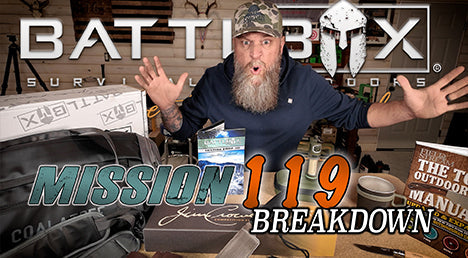Battlbox
What is SHTF Prepping: A Comprehensive Guide to Preparedness
Table of Contents
- Introduction
- Understanding the Concept of SHTF
- Identifying Potential SHTF Scenarios
- Key Components and Considerations for Building Your SHTF Plan
- Strategies for Immediate Action: Bug In or Bug Out
- Thriving Beyond the Initial Crisis
- Gear and Equipment Essentials
- Choosing the Best Gas Mask for SHTF Situations
- Conclusion
- Frequently Asked Questions
Introduction
Imagine waking up one morning to find that your daily routine has been completely upended. Grocery store shelves are empty, the power grid is down, and communication systems have failed. This isn't a scene from a post-apocalyptic movie; it's what many refer to as an SHTF (Shit Hits The Fan) scenario. This term encapsulates a wide range of potential crises that can disrupt everyday life, from natural disasters to societal collapse.
Understanding what SHTF prepping is and why it matters has never been more essential. Recent events—from the pandemic to natural disasters—have shown us that preparedness can make a significant difference during emergencies. In this blog post, we’ll explore the key components of SHTF prepping, the types of scenarios to prepare for, the gear you’ll need, and how to foster a community-oriented approach to survival.
By the end of this guide, you will have a thorough understanding of SHTF prepping and how to implement effective strategies to ensure you and your community are ready for the unexpected.
Understanding the Concept of SHTF
SHTF prepping is a mindset rooted in readiness and resilience. It involves preparing for emergencies that can disrupt daily life, whether they stem from natural disasters like hurricanes and earthquakes, economic collapses, or civil unrest. The concept isn't about living in fear; it's about empowering yourself to face uncertainties with confidence.
Historically, humans have always prepared for unforeseen circumstances. Our ancestors learned to stockpile food and resources to survive harsh winters and natural disasters. Today’s SHTF prepping is an evolution of these practices, adapted to modern threats and challenges.
The Mental Shift
One of the first steps in SHTF prepping is changing your mentality. Instead of dismissing potential disasters as improbable, embrace the idea that they can happen anywhere, anytime. Preparing for these eventualities is not an act of paranoia; instead, it is a proactive approach to safeguarding yourself and your loved ones.
Real-World Examples
To illustrate the importance of SHTF prepping, consider the following real-life events:
-
Hurricane Katrina (2005): This catastrophic storm devastated the Gulf Coast and left New Orleans in chaos. Many residents were unprepared, resulting in significant loss of life and property.
-
COVID-19 Pandemic (2020): The global pandemic highlighted the fragility of supply chains and the importance of having essentials on hand.
-
Texas Winter Storm (2021): A severe winter storm caused widespread power outages, leaving millions without heat or water for days.
These examples underscore that SHTF scenarios can occur regardless of location or time, emphasizing the need for preparedness.
Identifying Potential SHTF Scenarios
Understanding the types of SHTF scenarios is crucial for effective prepping. Here are some categories to consider:
Natural Disasters
- Hurricanes: Coastal areas often face hurricanes, causing destruction and flooding.
- Earthquakes: Regions near fault lines must prepare for sudden seismic activity.
- Floods: Heavy rainfall and rising water levels can devastate communities.
Man-Made Disasters
- Economic Collapse: A sudden downturn in the economy can create scarcity and civil unrest.
- Civil Unrest: Protests and riots can escalate, leading to violence and disruption.
- Cyber Attacks: A significant cyber attack can cripple essential services, including power and communication.
Long-Term Emergencies
- Pandemics: As seen with COVID-19, a widespread health crisis can disrupt daily life for extended periods.
- Nuclear Incidents: The threat of nuclear war or accidents necessitates preparation for fallout and radiation exposure.
Assessing Risks
Evaluate your local area for potential SHTF scenarios. Consider factors such as geography, climate, and socio-economic conditions. This assessment will guide your prepping strategy.
Key Components and Considerations for Building Your SHTF Plan
A well-rounded SHTF plan includes several key components. These ensure that you are prepared for various emergencies, regardless of their nature.
1. Food and Water Supply
Stockpiling Non-Perishables: Aim for a minimum of a two-week supply of non-perishable food items, gradually increasing to a month or more. Ideal choices include canned goods, rice, beans, and freeze-dried meals.
Water Storage: Store at least one gallon of water per person per day. Consider purification methods, such as water filters and purification tablets, to ensure access to safe drinking water.
2. Emergency Gear
Invest in essential survival gear to enhance your preparedness:
- First Aid Kit: A well-stocked first aid kit is crucial for treating injuries.
- Flashlights and Batteries: Power outages can occur during emergencies; having reliable lighting is essential.
- Multi-tool or Survival Knife: These tools can assist in various tasks, from food preparation to shelter building.
- Fire Starter Kit: Fire is vital for warmth, cooking, and signaling for help.
3. Shelter and Security
Home Fortification: Reinforce your home by securing windows and doors. Consider investing in security systems or alarms for added protection.
Bug-Out Bag: Prepare a bug-out bag with essential items for quick evacuation. This should include food, water, clothing, tools, and personal documents.
4. Training and Skills Development
First Aid Training: Knowing how to perform first aid can save lives during emergencies. Consider enrolling in courses to enhance your skills.
Self-Defense: Learn basic self-defense techniques to protect yourself and your loved ones during potential threats.
Wilderness Survival Skills: Familiarize yourself with essential survival skills, such as fire-starting, foraging, and navigation.
5. Community Engagement
Build a Network: Connect with like-minded individuals in your community. This network can provide support, share resources, and enhance overall preparedness.
Practice Together: Organize training sessions or drills with your community to practice emergency responses and improve teamwork.
Strategies for Immediate Action: Bug In or Bug Out
When an SHTF scenario occurs, you'll often need to decide whether to "bug in" (stay at home) or "bug out" (evacuate to a safer location). Each strategy has its advantages and considerations.
Bug In: Staying Home
Advantages:
- Familiarity: Your home is stocked with supplies and resources.
- Control: You can manage your food, water, and security without relying on external sources.
- Safety: During certain emergencies, staying put may be safer than venturing into potentially dangerous situations.
Considerations:
- Security: Ensure your home is fortified against potential threats.
- Supply Management: Monitor your supplies and ration them as needed.
Bug Out: Evacuating
When to Bug Out:
- Severe natural disasters (e.g., wildfires, floods).
- Widespread civil unrest or violence.
- Situations where your home is no longer safe.
Advantages:
- Access to safer environments: Evacuating can lead you away from danger zones.
- Opportunity for regrouping: Relocating may offer access to crucial resources.
Considerations:
- Evacuation routes: Plan your escape routes in advance to avoid congested areas.
- Bug-Out Bag: Have your bug-out bag ready to go at a moment's notice.
Thriving Beyond the Initial Crisis
It's essential to think about what comes after the initial SHTF event. Long-term survival requires more than just immediate preparation; it involves sustainable living.
Long-Term Food Storage
Learn skills for food preservation, such as canning, dehydrating, and gardening. This knowledge will help you extend your food supply beyond initial stockpiles.
Building Community Resilience
Fostering connections within your community is crucial for long-term survival. Share resources, skills, and knowledge to create a stronger, more resilient network.
Psychological Preparedness
SHTF scenarios can take an emotional toll. Building mental resilience is essential to navigate challenges during and after a crisis. Engage in activities that promote mental well-being, such as mindfulness, exercise, and maintaining social connections.
Gear and Equipment Essentials
To effectively prepare for SHTF scenarios, you’ll need to invest in quality gear and equipment. Here’s a comprehensive list of essentials:
- Water Filtration Systems: Ensure access to safe drinking water.
- Portable Cooking Equipment: Consider camping stoves or solar ovens for meal preparation.
- Emergency Shelter: Tents, tarps, or emergency blankets for outdoor use.
- Self-Defense Tools: Pepper spray, stun guns, or firearms (if legal and trained).
- Hiking Gear: Sturdy boots, backpacks, and clothing suitable for various weather conditions.
Choosing the Best Gas Mask for SHTF Situations
In certain emergencies, air quality can become a serious concern. A quality gas mask can protect against toxic substances, smoke, and airborne hazards. Here are some considerations when selecting a gas mask:
Key Features to Look For
- Filter Types: Ensure the mask has filters that can handle a range of contaminants, including chemicals and biological agents.
- Comfort and Fit: A good seal is essential for effective protection. Choose a mask that fits your face comfortably.
- Durability: Look for masks made of high-quality materials to withstand harsh conditions.
Recommended Options
- MIRA Safety CM-6M Gas Mask: Offers comprehensive protection against various hazards, including CBRN agents and smoke.
- VK-530 Filters: Designed to filter out harmful particulates and gases, ideal for wildfire scenarios.
Conclusion
SHTF prepping is a vital practice that empowers individuals and communities to face unexpected challenges with confidence. By understanding potential scenarios, developing a comprehensive plan, and fostering a sense of community, you can enhance your resilience and preparedness.
At Battlbox, we are committed to providing high-quality gear and resources to help you prepare for any situation. Explore our Battlbox Subscription Services, including the Basic Subscription and Pro Plus Subscription, to receive tailored survival gear delivered to your door each month.
Additionally, check out our Battlbox Shop for a variety of essential products, including those in our Emergency Disaster Preparedness collection.
Prepping is not just about survival; it's about thriving in the face of adversity. Equip yourself, stay informed, and engage with your community to foster resilience. Are you ready to prepare for the unexpected?
Frequently Asked Questions
What does SHTF stand for?
SHTF stands for "Shit Hits The Fan," a term used to describe critical situations that can lead to widespread disaster or crisis.
Do I need an SHTF plan?
Yes, having an SHTF plan is crucial for responding effectively to emergencies. It helps you anticipate potential challenges and prepare accordingly.
How do I start building an SHTF plan?
Start by assessing your specific risks based on your location. Gradually build your supplies and knowledge, focusing on food, water, and essential gear.
Are gas masks worth it for SHTF prepping?
Investing in a quality gas mask can significantly enhance your safety during specific emergencies, especially those involving airborne hazards.
How do you survive when SHTF?
Focus on the essentials: shelter, water, food, and security. Preparation is key; plan ahead, remain calm, and adapt as needed.
By following these guidelines and maintaining a proactive approach, you can be better prepared to face any SHTF scenario that comes your way.
Share on:

















